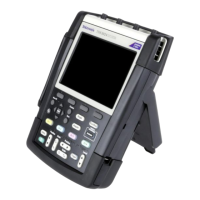Introduction
Duty Cycle: Pos
itive, Negative
mAs (current): Sensitivity (100 μV/A, 1 mV/A, 100 mV/A, 400 mV/A,
1V/A,10V/A,100V/A)
The RECORDER REPLAY submenu. This submenu provides options for recording
measurement data and screen imag es, and contains the following:
Trend Plot: Recorder Run/Stop, Options (Time of Day, From Start), View
All, Normal, Exit Recorder
Scope Roll Mode: Recorder Run/Stop, Exit Recorder
Data Log Replay: Previous, Next, Play, Exit Replay
The ACQUIRE OPTIONS submenu. This submenu provides acquisition options
and contains the following:
Glitch: On, Off
Memory: Short, Long
Average: Off, On (Average factor: 2, 4, 8, 64; Average: normal, smart)
Waveform: Normal, Per
sistence (Off, Short, Medium, Long, Infinite, Display
Normal, Display Envelope, Display Dot-join OFF), Mathematics (Function,
Source A, Source B), Reference (On, Off, New, Recall, Pass/Fail Testing Off,
Pass/Fail Testing Store Fail, Pass/Fail Testing Store Pass)
Autoset (AutoRange)
Pressing the Autoset button results in the automatic setup of all active channels
for vertical, horizontal, and trigger systems. Press and hold the Autoset button to
activate the AutoRange function. This function p rovides continuous auto setup
of vertical, horizontal, and trigger systems that track signal changes. Neither the
Autoset function nor the AutoRange function has a dedicated setup menu. You
can change Autoset mode from the Utility>Options>Auto Set Adjust menu.
Ch 1 – Ch 4
The Ch 1 and other channel buttons allow you to set probe input and probe
parameters as follows:
The INPUT 1 menu. This menu allows you to turn Input 1 On and O
ff.
The COUPLING menu. This menu allows you to set input coupling to DC or AC.
The PROBE 1 submenu. This submenu allows you t o set the probe type and
attenuation or sensitivity as follows:
4 THS3000 Series Oscilloscopes User Manual

